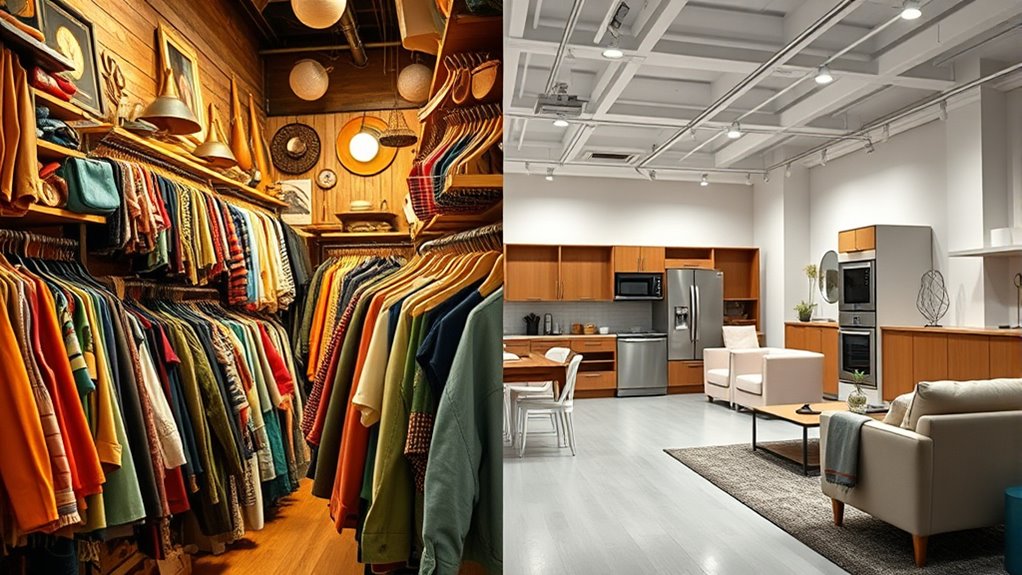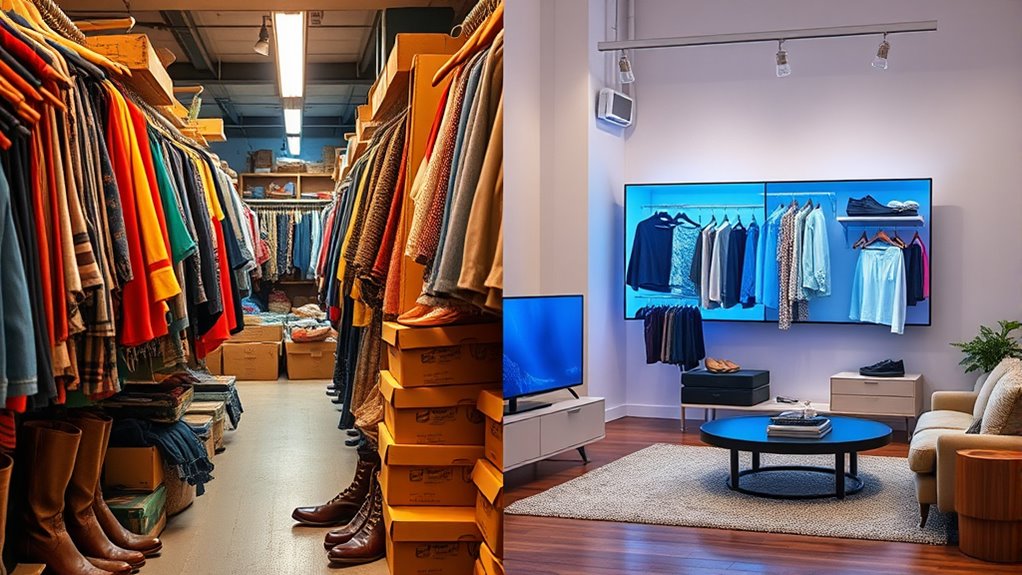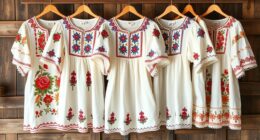In 2025, whether thrifting or renting saves you more depends on your habits and priorities. Thrifting is budget-friendly for building a unique, sustainable wardrobe but takes time and effort. Renting is cost-effective for short-term needs like special occasions with less hassle. Consider how often you dress up or hunt for vintage pieces. If you want a clearer picture, there’s more to explore about which option fits your lifestyle best.
Key Takeaways
- Thrifting offers long-term savings by building a sustainable wardrobe with affordable vintage pieces.
- Renting is cost-effective for occasional use, especially for high-end or luxury items.
- Both options reduce environmental impact compared to fast fashion, supporting eco-friendly choices.
- Thrifting requires more time and effort, while renting provides quick access for special occasions.
- Your savings depend on usage frequency, style needs, and personal priorities in 2025.

When choosing between thrifting and renting, you’re faced with two budget-friendly options that can help you save money and reduce waste. Both strategies align with the principles of sustainable fashion, allowing you to enjoy stylish clothing without the guilt of contributing to fast fashion’s environmental toll. To determine which method offers the best savings, it’s essential to do a clear cost comparison, considering factors like frequency of use, clothing quality, and the types of items you need.
Thrifting involves purchasing secondhand clothes at thrift stores, online marketplaces, or garage sales. It’s often cheaper upfront, especially if you’re hunting for vintage or unique pieces, and it supports sustainable fashion by extending the life cycle of garments. Plus, you get the satisfaction of finding one-of-a-kind items that reflect your personal style. However, keep in mind that thrifting can sometimes mean spending extra time browsing and hunting for the perfect item. If you’re someone who values instant gratification or specific high-end pieces, thrifting might require patience and effort.
Renting, on the other hand, is a convenient way to access high-quality, trendy clothing for a limited period. It’s especially popular for special occasions like weddings or parties where investing in a new outfit might not make sense. When doing a cost comparison, renting can be more economical if you only need an item once or twice. It also allows you to wear designer labels or luxury brands without paying the full retail price, which can add up over time. While rental services typically charge a fee per item or subscription, they often include dry cleaning and maintenance, saving you money and hassle.
In terms of sustainable fashion, both options reduce environmental impact compared to fast fashion. Thrifting keeps clothes in circulation longer, preventing waste, while renting reduces the need for constantly buying new garments, cutting down on production-related emissions. The choice depends on your shopping habits and lifestyle. If you love hunting for vintage gems and enjoy the thrill of thrifting, it’s likely more cost-effective in the long run. But if you prefer convenience and access to high-end pieces occasionally, renting might offer better value.
Ultimately, it’s about your personal priorities. Do you want a sustainable way to build a wardrobe over time? Or do you prefer the flexibility of trying out different styles without a long-term commitment? Both thrifting and renting can help you save money while supporting sustainable fashion. Comparing their costs based on your needs will guide you toward the more budget-friendly choice in 2025.
Frequently Asked Questions
How Do Maintenance Costs Compare Between Thrifting and Renting?
When comparing maintenance costs, renting often covers repair expenses, reducing your worries about wear and tear. You typically won’t pay for major repairs, as they’re included in your rental fee. Thrifting, on the other hand, means you’re responsible for any wear and tear, which can lead to unexpected repair costs. So, renting usually offers lower maintenance costs, while thrifting might mean more expenses if items break or need fixing.
What Are the Environmental Impacts of Thrifting Versus Renting?
You can make a big impact by choosing thrifting or renting, as both promote sustainable practices and waste reduction. Thrifting reduces textile waste and lessens demand for new production, while renting extends the life of items and minimizes resource use. Your choices help cut down environmental harm, encouraging a circular economy. By opting for these options, you support eco-friendly habits that benefit the planet now and in the future.
Can I Customize Items More Easily When Thrifting or Renting?
Imagine turning a blank canvas into your masterpiece—that’s what customizing thrifting or renting items feels like. When you thrift, you enjoy greater modification flexibility and personalization options, letting you add your unique touch more easily. Renting often limits these options, as items are meant to stay pristine. So, if you crave complete control over your style, thrifting gives you the freedom to customize without restrictions.
How Do Return Policies Differ Between Thrift Stores and Rental Services?
You’ll find that return procedures and store policies differ considerably between thrift stores and rental services. Thrift stores generally have lenient return policies, often offering refunds or exchanges within a set period if items are unused. Rental services, however, enforce stricter return procedures to ensure items are returned in good condition, often with detailed guidelines and fees for late or damaged items. Understanding these policies helps you avoid surprises and manage your returns smoothly.
Which Option Offers Better Long-Term Financial Savings?
Did you know that over time, thrifting can save you up to 70% compared to buying new? When you do a cost analysis, thrifting often offers better long-term financial savings because you’re investing less upfront. Renting can be flexible, but it tends to cost more over extended periods. So, if you’re aiming for maximum savings and investment potential, thrifting is usually the smarter choice in the long run.
Conclusion
So, whether you choose thrifting or renting in 2025, you can save big. Imagine renting a stylish dress for a special event instead of buying it — you save money and reduce waste. Or, consider thrifting for everyday clothes, giving new life to secondhand finds. Both options help you cut costs while being eco-friendly. The key is to pick what fits your lifestyle and budget, making smart choices that stretch your dollar further.









